Tesco's Strategic Positioning: A Comprehensive Environmental Analysis
VerifiedAdded on 2023/06/18
|19
|6413
|407
Report
AI Summary
This report provides a comprehensive strategic analysis of Tesco, a British multinational retail company. It utilizes the PESTLE framework to evaluate macro-environmental factors like political, economic, social, technological, legal, and environmental influences, assessing their impact on Tesco's strategies. The report also includes a SWOT analysis to examine Tesco's internal strengths and weaknesses, as well as external opportunities and threats. Porter's Five Forces model is applied to understand the competitive landscape. Furthermore, the report discusses appropriate strategies for Tesco to maintain a competitive edge, including market penetration and product development, and critiques the application of environmental and competitive analysis to suggest strategic directions and objectives. The analysis concludes with recommendations for Tesco to leverage its strengths and address its weaknesses in the dynamic market environment.
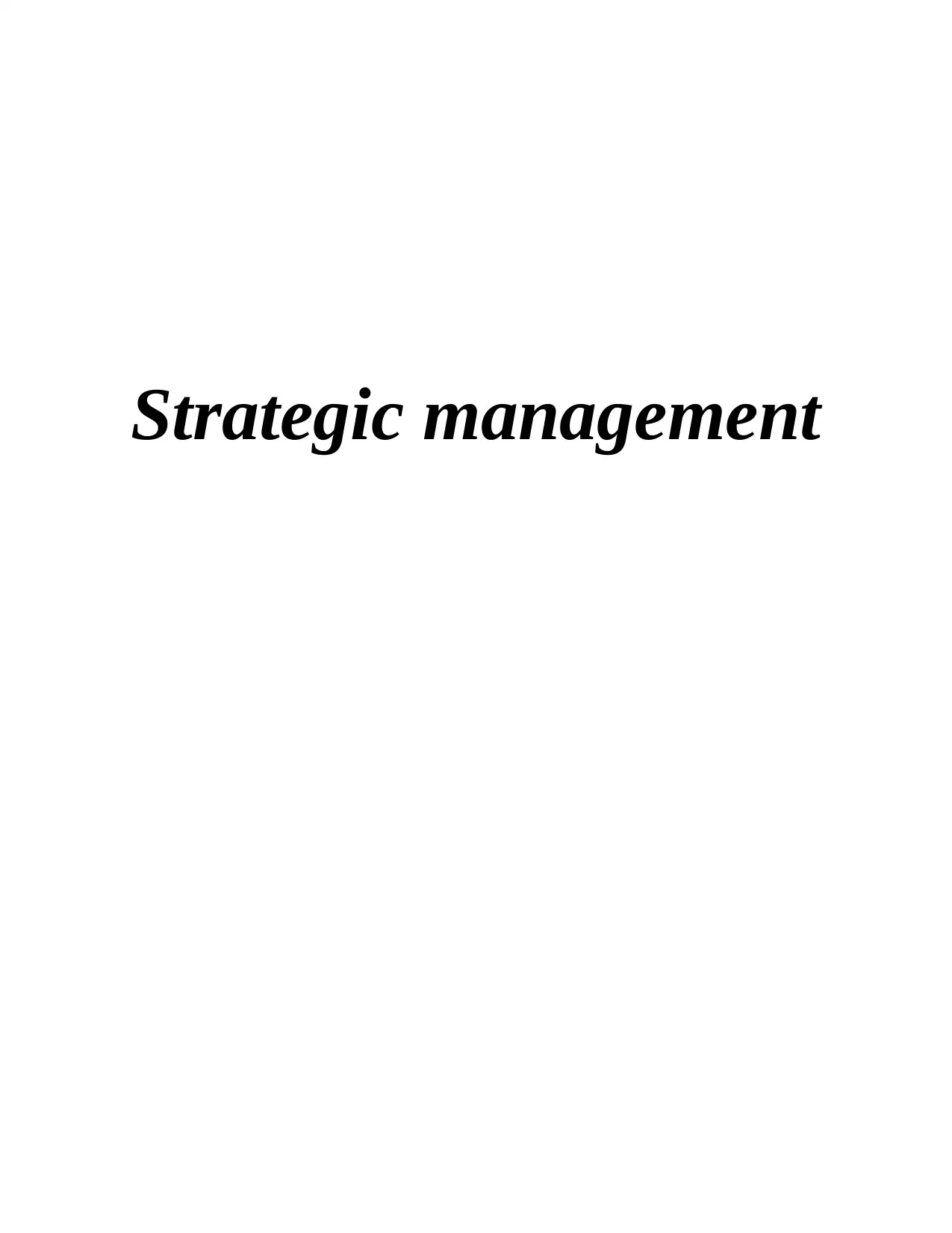
Strategic management
Paraphrase This Document
Need a fresh take? Get an instant paraphrase of this document with our AI Paraphraser
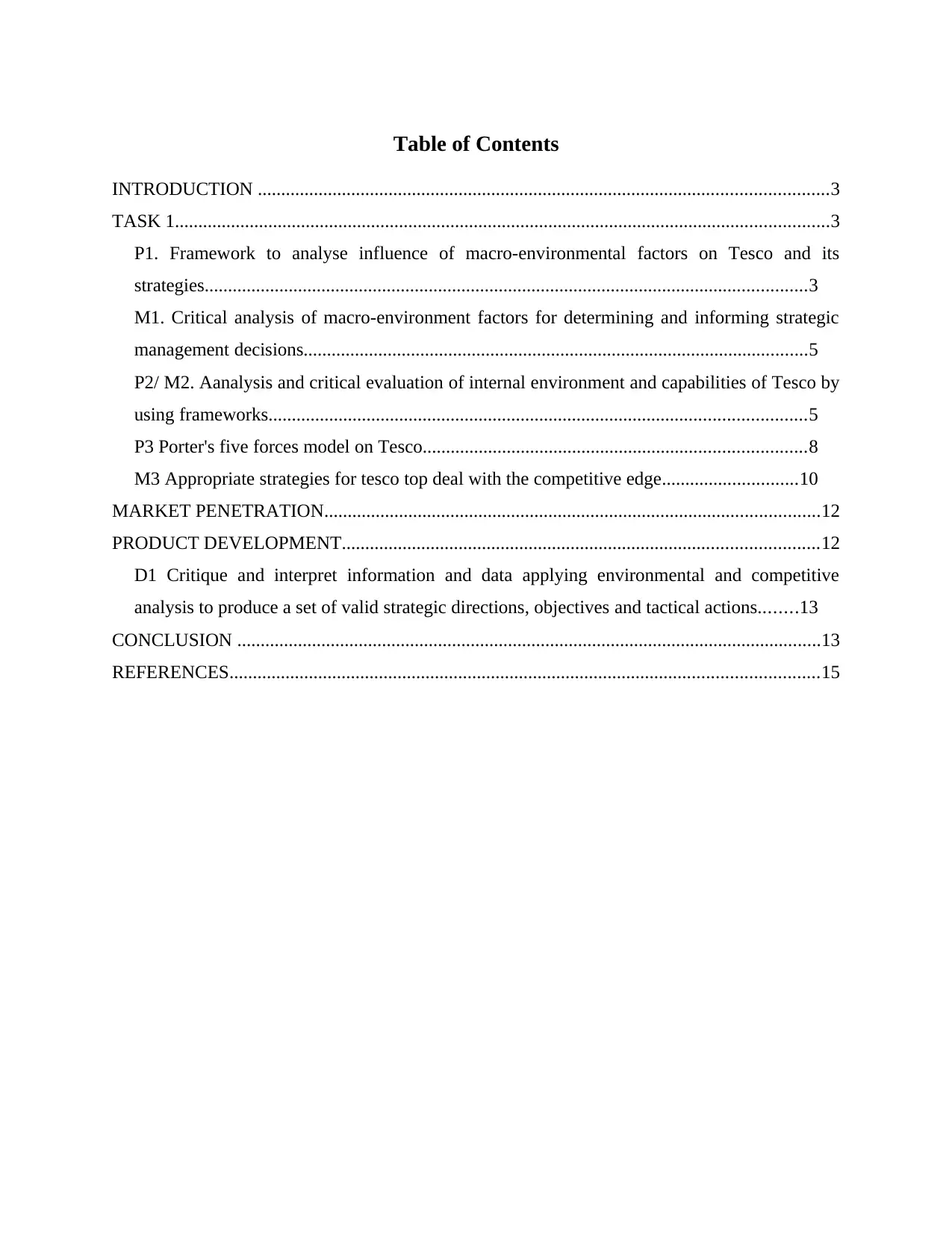
Table of Contents
INTRODUCTION ..........................................................................................................................3
TASK 1............................................................................................................................................3
P1. Framework to analyse influence of macro-environmental factors on Tesco and its
strategies.................................................................................................................................3
M1. Critical analysis of macro-environment factors for determining and informing strategic
management decisions............................................................................................................5
P2/ M2. Aanalysis and critical evaluation of internal environment and capabilities of Tesco by
using frameworks...................................................................................................................5
P3 Porter's five forces model on Tesco..................................................................................8
M3 Appropriate strategies for tesco top deal with the competitive edge.............................10
MARKET PENETRATION..........................................................................................................12
PRODUCT DEVELOPMENT......................................................................................................12
D1 Critique and interpret information and data applying environmental and competitive
analysis to produce a set of valid strategic directions, objectives and tactical actions........13
CONCLUSION .............................................................................................................................13
REFERENCES..............................................................................................................................15
INTRODUCTION ..........................................................................................................................3
TASK 1............................................................................................................................................3
P1. Framework to analyse influence of macro-environmental factors on Tesco and its
strategies.................................................................................................................................3
M1. Critical analysis of macro-environment factors for determining and informing strategic
management decisions............................................................................................................5
P2/ M2. Aanalysis and critical evaluation of internal environment and capabilities of Tesco by
using frameworks...................................................................................................................5
P3 Porter's five forces model on Tesco..................................................................................8
M3 Appropriate strategies for tesco top deal with the competitive edge.............................10
MARKET PENETRATION..........................................................................................................12
PRODUCT DEVELOPMENT......................................................................................................12
D1 Critique and interpret information and data applying environmental and competitive
analysis to produce a set of valid strategic directions, objectives and tactical actions........13
CONCLUSION .............................................................................................................................13
REFERENCES..............................................................................................................................15
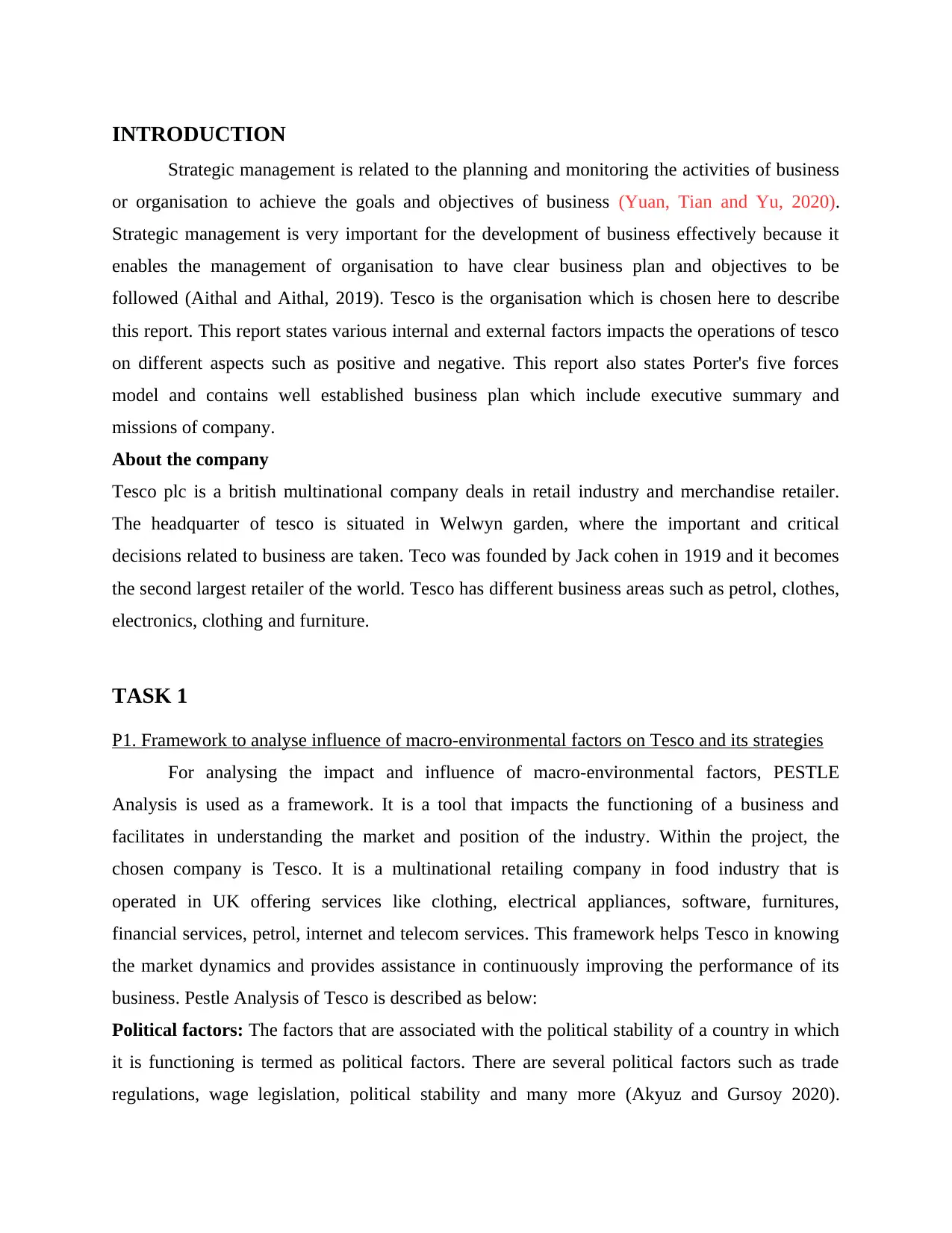
INTRODUCTION
Strategic management is related to the planning and monitoring the activities of business
or organisation to achieve the goals and objectives of business (Yuan, Tian and Yu, 2020).
Strategic management is very important for the development of business effectively because it
enables the management of organisation to have clear business plan and objectives to be
followed (Aithal and Aithal, 2019). Tesco is the organisation which is chosen here to describe
this report. This report states various internal and external factors impacts the operations of tesco
on different aspects such as positive and negative. This report also states Porter's five forces
model and contains well established business plan which include executive summary and
missions of company.
About the company
Tesco plc is a british multinational company deals in retail industry and merchandise retailer.
The headquarter of tesco is situated in Welwyn garden, where the important and critical
decisions related to business are taken. Teco was founded by Jack cohen in 1919 and it becomes
the second largest retailer of the world. Tesco has different business areas such as petrol, clothes,
electronics, clothing and furniture.
TASK 1
P1. Framework to analyse influence of macro-environmental factors on Tesco and its strategies
For analysing the impact and influence of macro-environmental factors, PESTLE
Analysis is used as a framework. It is a tool that impacts the functioning of a business and
facilitates in understanding the market and position of the industry. Within the project, the
chosen company is Tesco. It is a multinational retailing company in food industry that is
operated in UK offering services like clothing, electrical appliances, software, furnitures,
financial services, petrol, internet and telecom services. This framework helps Tesco in knowing
the market dynamics and provides assistance in continuously improving the performance of its
business. Pestle Analysis of Tesco is described as below:
Political factors: The factors that are associated with the political stability of a country in which
it is functioning is termed as political factors. There are several political factors such as trade
regulations, wage legislation, political stability and many more (Akyuz and Gursoy 2020).
Strategic management is related to the planning and monitoring the activities of business
or organisation to achieve the goals and objectives of business (Yuan, Tian and Yu, 2020).
Strategic management is very important for the development of business effectively because it
enables the management of organisation to have clear business plan and objectives to be
followed (Aithal and Aithal, 2019). Tesco is the organisation which is chosen here to describe
this report. This report states various internal and external factors impacts the operations of tesco
on different aspects such as positive and negative. This report also states Porter's five forces
model and contains well established business plan which include executive summary and
missions of company.
About the company
Tesco plc is a british multinational company deals in retail industry and merchandise retailer.
The headquarter of tesco is situated in Welwyn garden, where the important and critical
decisions related to business are taken. Teco was founded by Jack cohen in 1919 and it becomes
the second largest retailer of the world. Tesco has different business areas such as petrol, clothes,
electronics, clothing and furniture.
TASK 1
P1. Framework to analyse influence of macro-environmental factors on Tesco and its strategies
For analysing the impact and influence of macro-environmental factors, PESTLE
Analysis is used as a framework. It is a tool that impacts the functioning of a business and
facilitates in understanding the market and position of the industry. Within the project, the
chosen company is Tesco. It is a multinational retailing company in food industry that is
operated in UK offering services like clothing, electrical appliances, software, furnitures,
financial services, petrol, internet and telecom services. This framework helps Tesco in knowing
the market dynamics and provides assistance in continuously improving the performance of its
business. Pestle Analysis of Tesco is described as below:
Political factors: The factors that are associated with the political stability of a country in which
it is functioning is termed as political factors. There are several political factors such as trade
regulations, wage legislation, political stability and many more (Akyuz and Gursoy 2020).
⊘ This is a preview!⊘
Do you want full access?
Subscribe today to unlock all pages.

Trusted by 1+ million students worldwide
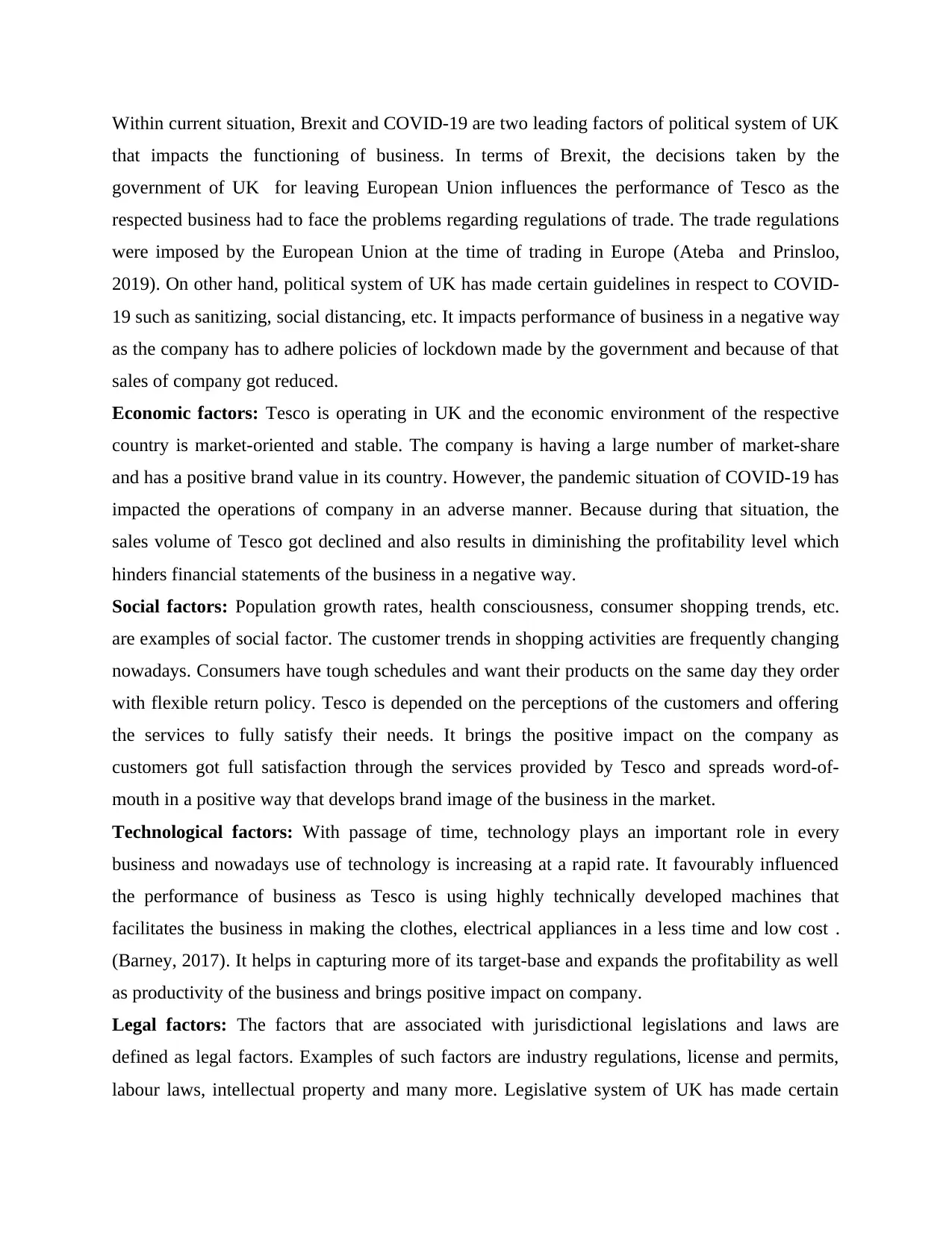
Within current situation, Brexit and COVID-19 are two leading factors of political system of UK
that impacts the functioning of business. In terms of Brexit, the decisions taken by the
government of UK for leaving European Union influences the performance of Tesco as the
respected business had to face the problems regarding regulations of trade. The trade regulations
were imposed by the European Union at the time of trading in Europe (Ateba and Prinsloo,
2019). On other hand, political system of UK has made certain guidelines in respect to COVID-
19 such as sanitizing, social distancing, etc. It impacts performance of business in a negative way
as the company has to adhere policies of lockdown made by the government and because of that
sales of company got reduced.
Economic factors: Tesco is operating in UK and the economic environment of the respective
country is market-oriented and stable. The company is having a large number of market-share
and has a positive brand value in its country. However, the pandemic situation of COVID-19 has
impacted the operations of company in an adverse manner. Because during that situation, the
sales volume of Tesco got declined and also results in diminishing the profitability level which
hinders financial statements of the business in a negative way.
Social factors: Population growth rates, health consciousness, consumer shopping trends, etc.
are examples of social factor. The customer trends in shopping activities are frequently changing
nowadays. Consumers have tough schedules and want their products on the same day they order
with flexible return policy. Tesco is depended on the perceptions of the customers and offering
the services to fully satisfy their needs. It brings the positive impact on the company as
customers got full satisfaction through the services provided by Tesco and spreads word-of-
mouth in a positive way that develops brand image of the business in the market.
Technological factors: With passage of time, technology plays an important role in every
business and nowadays use of technology is increasing at a rapid rate. It favourably influenced
the performance of business as Tesco is using highly technically developed machines that
facilitates the business in making the clothes, electrical appliances in a less time and low cost .
(Barney, 2017). It helps in capturing more of its target-base and expands the profitability as well
as productivity of the business and brings positive impact on company.
Legal factors: The factors that are associated with jurisdictional legislations and laws are
defined as legal factors. Examples of such factors are industry regulations, license and permits,
labour laws, intellectual property and many more. Legislative system of UK has made certain
that impacts the functioning of business. In terms of Brexit, the decisions taken by the
government of UK for leaving European Union influences the performance of Tesco as the
respected business had to face the problems regarding regulations of trade. The trade regulations
were imposed by the European Union at the time of trading in Europe (Ateba and Prinsloo,
2019). On other hand, political system of UK has made certain guidelines in respect to COVID-
19 such as sanitizing, social distancing, etc. It impacts performance of business in a negative way
as the company has to adhere policies of lockdown made by the government and because of that
sales of company got reduced.
Economic factors: Tesco is operating in UK and the economic environment of the respective
country is market-oriented and stable. The company is having a large number of market-share
and has a positive brand value in its country. However, the pandemic situation of COVID-19 has
impacted the operations of company in an adverse manner. Because during that situation, the
sales volume of Tesco got declined and also results in diminishing the profitability level which
hinders financial statements of the business in a negative way.
Social factors: Population growth rates, health consciousness, consumer shopping trends, etc.
are examples of social factor. The customer trends in shopping activities are frequently changing
nowadays. Consumers have tough schedules and want their products on the same day they order
with flexible return policy. Tesco is depended on the perceptions of the customers and offering
the services to fully satisfy their needs. It brings the positive impact on the company as
customers got full satisfaction through the services provided by Tesco and spreads word-of-
mouth in a positive way that develops brand image of the business in the market.
Technological factors: With passage of time, technology plays an important role in every
business and nowadays use of technology is increasing at a rapid rate. It favourably influenced
the performance of business as Tesco is using highly technically developed machines that
facilitates the business in making the clothes, electrical appliances in a less time and low cost .
(Barney, 2017). It helps in capturing more of its target-base and expands the profitability as well
as productivity of the business and brings positive impact on company.
Legal factors: The factors that are associated with jurisdictional legislations and laws are
defined as legal factors. Examples of such factors are industry regulations, license and permits,
labour laws, intellectual property and many more. Legislative system of UK has made certain
Paraphrase This Document
Need a fresh take? Get an instant paraphrase of this document with our AI Paraphraser
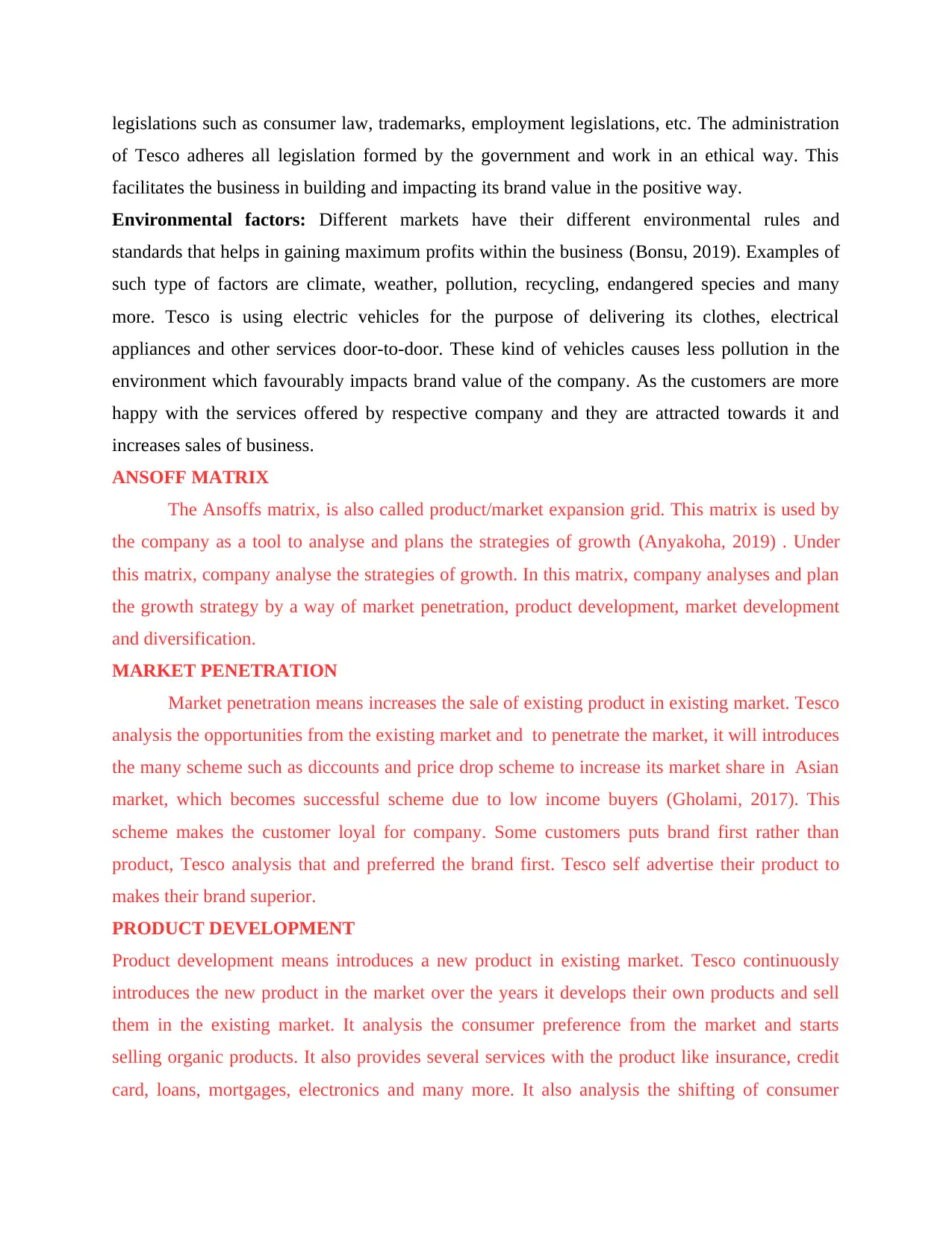
legislations such as consumer law, trademarks, employment legislations, etc. The administration
of Tesco adheres all legislation formed by the government and work in an ethical way. This
facilitates the business in building and impacting its brand value in the positive way.
Environmental factors: Different markets have their different environmental rules and
standards that helps in gaining maximum profits within the business (Bonsu, 2019). Examples of
such type of factors are climate, weather, pollution, recycling, endangered species and many
more. Tesco is using electric vehicles for the purpose of delivering its clothes, electrical
appliances and other services door-to-door. These kind of vehicles causes less pollution in the
environment which favourably impacts brand value of the company. As the customers are more
happy with the services offered by respective company and they are attracted towards it and
increases sales of business.
ANSOFF MATRIX
The Ansoffs matrix, is also called product/market expansion grid. This matrix is used by
the company as a tool to analyse and plans the strategies of growth (Anyakoha, 2019) . Under
this matrix, company analyse the strategies of growth. In this matrix, company analyses and plan
the growth strategy by a way of market penetration, product development, market development
and diversification.
MARKET PENETRATION
Market penetration means increases the sale of existing product in existing market. Tesco
analysis the opportunities from the existing market and to penetrate the market, it will introduces
the many scheme such as diccounts and price drop scheme to increase its market share in Asian
market, which becomes successful scheme due to low income buyers (Gholami, 2017). This
scheme makes the customer loyal for company. Some customers puts brand first rather than
product, Tesco analysis that and preferred the brand first. Tesco self advertise their product to
makes their brand superior.
PRODUCT DEVELOPMENT
Product development means introduces a new product in existing market. Tesco continuously
introduces the new product in the market over the years it develops their own products and sell
them in the existing market. It analysis the consumer preference from the market and starts
selling organic products. It also provides several services with the product like insurance, credit
card, loans, mortgages, electronics and many more. It also analysis the shifting of consumer
of Tesco adheres all legislation formed by the government and work in an ethical way. This
facilitates the business in building and impacting its brand value in the positive way.
Environmental factors: Different markets have their different environmental rules and
standards that helps in gaining maximum profits within the business (Bonsu, 2019). Examples of
such type of factors are climate, weather, pollution, recycling, endangered species and many
more. Tesco is using electric vehicles for the purpose of delivering its clothes, electrical
appliances and other services door-to-door. These kind of vehicles causes less pollution in the
environment which favourably impacts brand value of the company. As the customers are more
happy with the services offered by respective company and they are attracted towards it and
increases sales of business.
ANSOFF MATRIX
The Ansoffs matrix, is also called product/market expansion grid. This matrix is used by
the company as a tool to analyse and plans the strategies of growth (Anyakoha, 2019) . Under
this matrix, company analyse the strategies of growth. In this matrix, company analyses and plan
the growth strategy by a way of market penetration, product development, market development
and diversification.
MARKET PENETRATION
Market penetration means increases the sale of existing product in existing market. Tesco
analysis the opportunities from the existing market and to penetrate the market, it will introduces
the many scheme such as diccounts and price drop scheme to increase its market share in Asian
market, which becomes successful scheme due to low income buyers (Gholami, 2017). This
scheme makes the customer loyal for company. Some customers puts brand first rather than
product, Tesco analysis that and preferred the brand first. Tesco self advertise their product to
makes their brand superior.
PRODUCT DEVELOPMENT
Product development means introduces a new product in existing market. Tesco continuously
introduces the new product in the market over the years it develops their own products and sell
them in the existing market. It analysis the consumer preference from the market and starts
selling organic products. It also provides several services with the product like insurance, credit
card, loans, mortgages, electronics and many more. It also analysis the shifting of consumer
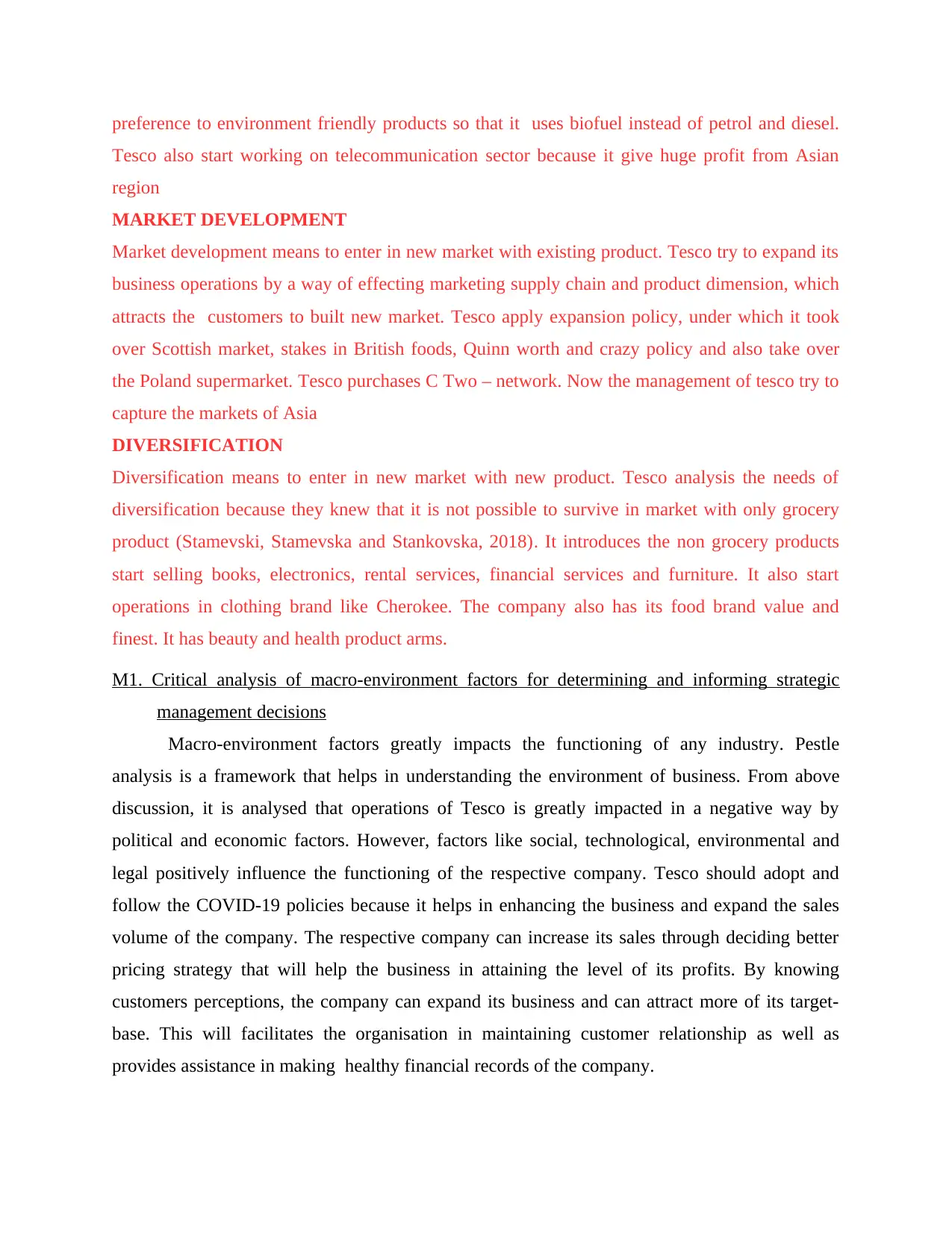
preference to environment friendly products so that it uses biofuel instead of petrol and diesel.
Tesco also start working on telecommunication sector because it give huge profit from Asian
region
MARKET DEVELOPMENT
Market development means to enter in new market with existing product. Tesco try to expand its
business operations by a way of effecting marketing supply chain and product dimension, which
attracts the customers to built new market. Tesco apply expansion policy, under which it took
over Scottish market, stakes in British foods, Quinn worth and crazy policy and also take over
the Poland supermarket. Tesco purchases C Two – network. Now the management of tesco try to
capture the markets of Asia
DIVERSIFICATION
Diversification means to enter in new market with new product. Tesco analysis the needs of
diversification because they knew that it is not possible to survive in market with only grocery
product (Stamevski, Stamevska and Stankovska, 2018). It introduces the non grocery products
start selling books, electronics, rental services, financial services and furniture. It also start
operations in clothing brand like Cherokee. The company also has its food brand value and
finest. It has beauty and health product arms.
M1. Critical analysis of macro-environment factors for determining and informing strategic
management decisions
Macro-environment factors greatly impacts the functioning of any industry. Pestle
analysis is a framework that helps in understanding the environment of business. From above
discussion, it is analysed that operations of Tesco is greatly impacted in a negative way by
political and economic factors. However, factors like social, technological, environmental and
legal positively influence the functioning of the respective company. Tesco should adopt and
follow the COVID-19 policies because it helps in enhancing the business and expand the sales
volume of the company. The respective company can increase its sales through deciding better
pricing strategy that will help the business in attaining the level of its profits. By knowing
customers perceptions, the company can expand its business and can attract more of its target-
base. This will facilitates the organisation in maintaining customer relationship as well as
provides assistance in making healthy financial records of the company.
Tesco also start working on telecommunication sector because it give huge profit from Asian
region
MARKET DEVELOPMENT
Market development means to enter in new market with existing product. Tesco try to expand its
business operations by a way of effecting marketing supply chain and product dimension, which
attracts the customers to built new market. Tesco apply expansion policy, under which it took
over Scottish market, stakes in British foods, Quinn worth and crazy policy and also take over
the Poland supermarket. Tesco purchases C Two – network. Now the management of tesco try to
capture the markets of Asia
DIVERSIFICATION
Diversification means to enter in new market with new product. Tesco analysis the needs of
diversification because they knew that it is not possible to survive in market with only grocery
product (Stamevski, Stamevska and Stankovska, 2018). It introduces the non grocery products
start selling books, electronics, rental services, financial services and furniture. It also start
operations in clothing brand like Cherokee. The company also has its food brand value and
finest. It has beauty and health product arms.
M1. Critical analysis of macro-environment factors for determining and informing strategic
management decisions
Macro-environment factors greatly impacts the functioning of any industry. Pestle
analysis is a framework that helps in understanding the environment of business. From above
discussion, it is analysed that operations of Tesco is greatly impacted in a negative way by
political and economic factors. However, factors like social, technological, environmental and
legal positively influence the functioning of the respective company. Tesco should adopt and
follow the COVID-19 policies because it helps in enhancing the business and expand the sales
volume of the company. The respective company can increase its sales through deciding better
pricing strategy that will help the business in attaining the level of its profits. By knowing
customers perceptions, the company can expand its business and can attract more of its target-
base. This will facilitates the organisation in maintaining customer relationship as well as
provides assistance in making healthy financial records of the company.
⊘ This is a preview!⊘
Do you want full access?
Subscribe today to unlock all pages.

Trusted by 1+ million students worldwide
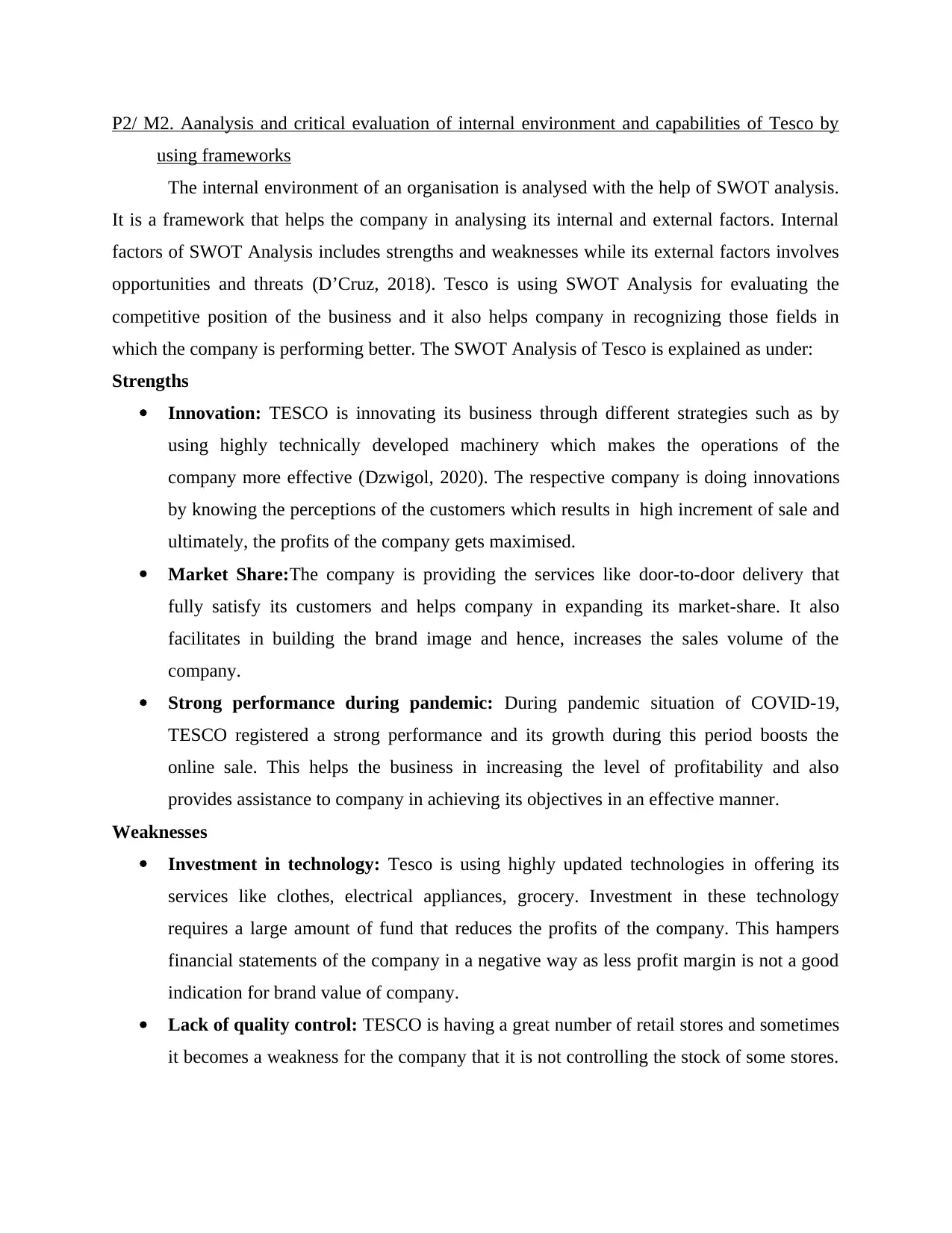
P2/ M2. Aanalysis and critical evaluation of internal environment and capabilities of Tesco by
using frameworks
The internal environment of an organisation is analysed with the help of SWOT analysis.
It is a framework that helps the company in analysing its internal and external factors. Internal
factors of SWOT Analysis includes strengths and weaknesses while its external factors involves
opportunities and threats (D’Cruz, 2018). Tesco is using SWOT Analysis for evaluating the
competitive position of the business and it also helps company in recognizing those fields in
which the company is performing better. The SWOT Analysis of Tesco is explained as under:
Strengths
Innovation: TESCO is innovating its business through different strategies such as by
using highly technically developed machinery which makes the operations of the
company more effective (Dzwigol, 2020). The respective company is doing innovations
by knowing the perceptions of the customers which results in high increment of sale and
ultimately, the profits of the company gets maximised.
Market Share:The company is providing the services like door-to-door delivery that
fully satisfy its customers and helps company in expanding its market-share. It also
facilitates in building the brand image and hence, increases the sales volume of the
company.
Strong performance during pandemic: During pandemic situation of COVID-19,
TESCO registered a strong performance and its growth during this period boosts the
online sale. This helps the business in increasing the level of profitability and also
provides assistance to company in achieving its objectives in an effective manner.
Weaknesses
Investment in technology: Tesco is using highly updated technologies in offering its
services like clothes, electrical appliances, grocery. Investment in these technology
requires a large amount of fund that reduces the profits of the company. This hampers
financial statements of the company in a negative way as less profit margin is not a good
indication for brand value of company.
Lack of quality control: TESCO is having a great number of retail stores and sometimes
it becomes a weakness for the company that it is not controlling the stock of some stores.
using frameworks
The internal environment of an organisation is analysed with the help of SWOT analysis.
It is a framework that helps the company in analysing its internal and external factors. Internal
factors of SWOT Analysis includes strengths and weaknesses while its external factors involves
opportunities and threats (D’Cruz, 2018). Tesco is using SWOT Analysis for evaluating the
competitive position of the business and it also helps company in recognizing those fields in
which the company is performing better. The SWOT Analysis of Tesco is explained as under:
Strengths
Innovation: TESCO is innovating its business through different strategies such as by
using highly technically developed machinery which makes the operations of the
company more effective (Dzwigol, 2020). The respective company is doing innovations
by knowing the perceptions of the customers which results in high increment of sale and
ultimately, the profits of the company gets maximised.
Market Share:The company is providing the services like door-to-door delivery that
fully satisfy its customers and helps company in expanding its market-share. It also
facilitates in building the brand image and hence, increases the sales volume of the
company.
Strong performance during pandemic: During pandemic situation of COVID-19,
TESCO registered a strong performance and its growth during this period boosts the
online sale. This helps the business in increasing the level of profitability and also
provides assistance to company in achieving its objectives in an effective manner.
Weaknesses
Investment in technology: Tesco is using highly updated technologies in offering its
services like clothes, electrical appliances, grocery. Investment in these technology
requires a large amount of fund that reduces the profits of the company. This hampers
financial statements of the company in a negative way as less profit margin is not a good
indication for brand value of company.
Lack of quality control: TESCO is having a great number of retail stores and sometimes
it becomes a weakness for the company that it is not controlling the stock of some stores.
Paraphrase This Document
Need a fresh take? Get an instant paraphrase of this document with our AI Paraphraser
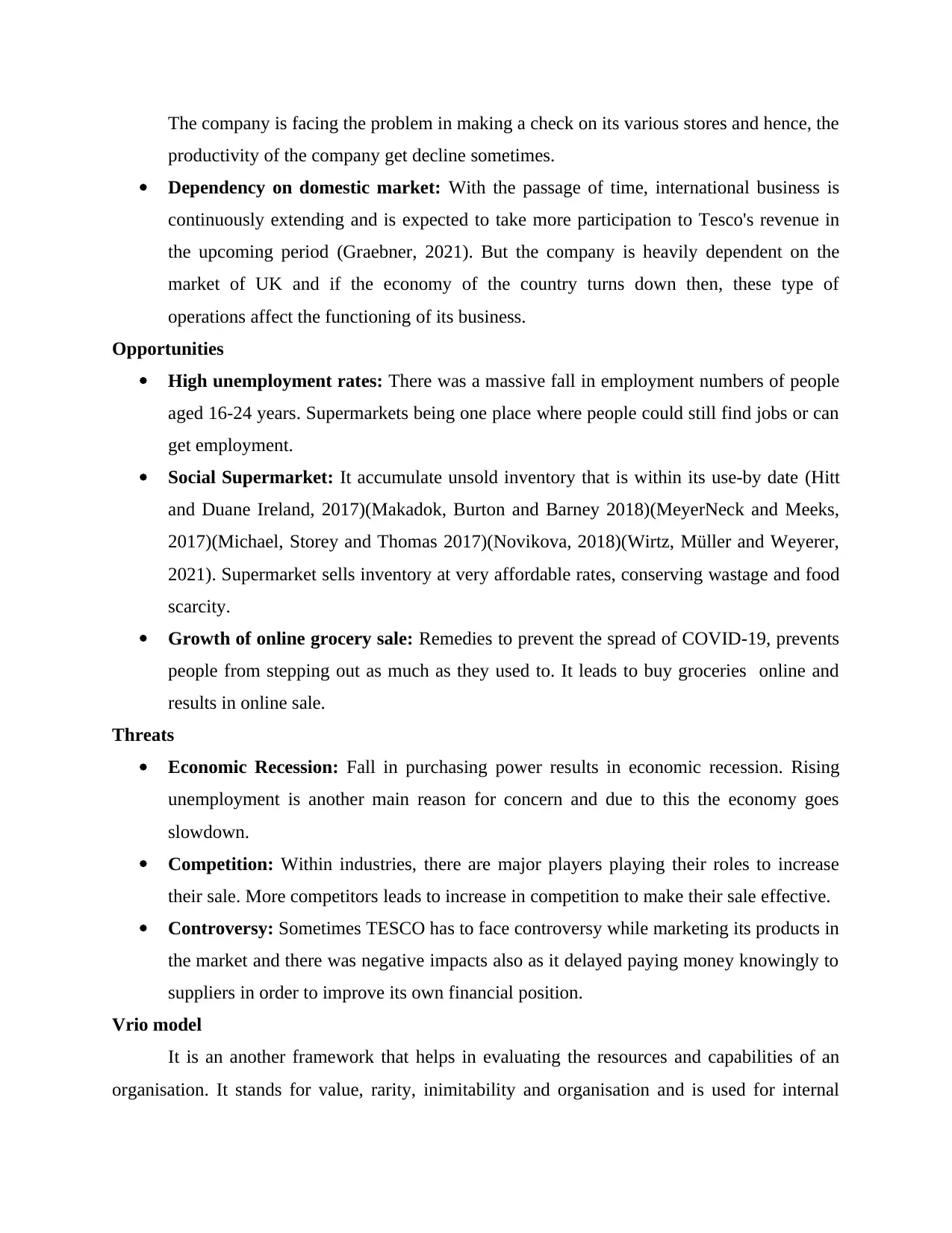
The company is facing the problem in making a check on its various stores and hence, the
productivity of the company get decline sometimes.
Dependency on domestic market: With the passage of time, international business is
continuously extending and is expected to take more participation to Tesco's revenue in
the upcoming period (Graebner, 2021). But the company is heavily dependent on the
market of UK and if the economy of the country turns down then, these type of
operations affect the functioning of its business.
Opportunities
High unemployment rates: There was a massive fall in employment numbers of people
aged 16-24 years. Supermarkets being one place where people could still find jobs or can
get employment.
Social Supermarket: It accumulate unsold inventory that is within its use-by date (Hitt
and Duane Ireland, 2017)(Makadok, Burton and Barney 2018)(MeyerNeck and Meeks,
2017)(Michael, Storey and Thomas 2017)(Novikova, 2018)(Wirtz, Müller and Weyerer,
2021). Supermarket sells inventory at very affordable rates, conserving wastage and food
scarcity.
Growth of online grocery sale: Remedies to prevent the spread of COVID-19, prevents
people from stepping out as much as they used to. It leads to buy groceries online and
results in online sale.
Threats
Economic Recession: Fall in purchasing power results in economic recession. Rising
unemployment is another main reason for concern and due to this the economy goes
slowdown.
Competition: Within industries, there are major players playing their roles to increase
their sale. More competitors leads to increase in competition to make their sale effective.
Controversy: Sometimes TESCO has to face controversy while marketing its products in
the market and there was negative impacts also as it delayed paying money knowingly to
suppliers in order to improve its own financial position.
Vrio model
It is an another framework that helps in evaluating the resources and capabilities of an
organisation. It stands for value, rarity, inimitability and organisation and is used for internal
productivity of the company get decline sometimes.
Dependency on domestic market: With the passage of time, international business is
continuously extending and is expected to take more participation to Tesco's revenue in
the upcoming period (Graebner, 2021). But the company is heavily dependent on the
market of UK and if the economy of the country turns down then, these type of
operations affect the functioning of its business.
Opportunities
High unemployment rates: There was a massive fall in employment numbers of people
aged 16-24 years. Supermarkets being one place where people could still find jobs or can
get employment.
Social Supermarket: It accumulate unsold inventory that is within its use-by date (Hitt
and Duane Ireland, 2017)(Makadok, Burton and Barney 2018)(MeyerNeck and Meeks,
2017)(Michael, Storey and Thomas 2017)(Novikova, 2018)(Wirtz, Müller and Weyerer,
2021). Supermarket sells inventory at very affordable rates, conserving wastage and food
scarcity.
Growth of online grocery sale: Remedies to prevent the spread of COVID-19, prevents
people from stepping out as much as they used to. It leads to buy groceries online and
results in online sale.
Threats
Economic Recession: Fall in purchasing power results in economic recession. Rising
unemployment is another main reason for concern and due to this the economy goes
slowdown.
Competition: Within industries, there are major players playing their roles to increase
their sale. More competitors leads to increase in competition to make their sale effective.
Controversy: Sometimes TESCO has to face controversy while marketing its products in
the market and there was negative impacts also as it delayed paying money knowingly to
suppliers in order to improve its own financial position.
Vrio model
It is an another framework that helps in evaluating the resources and capabilities of an
organisation. It stands for value, rarity, inimitability and organisation and is used for internal
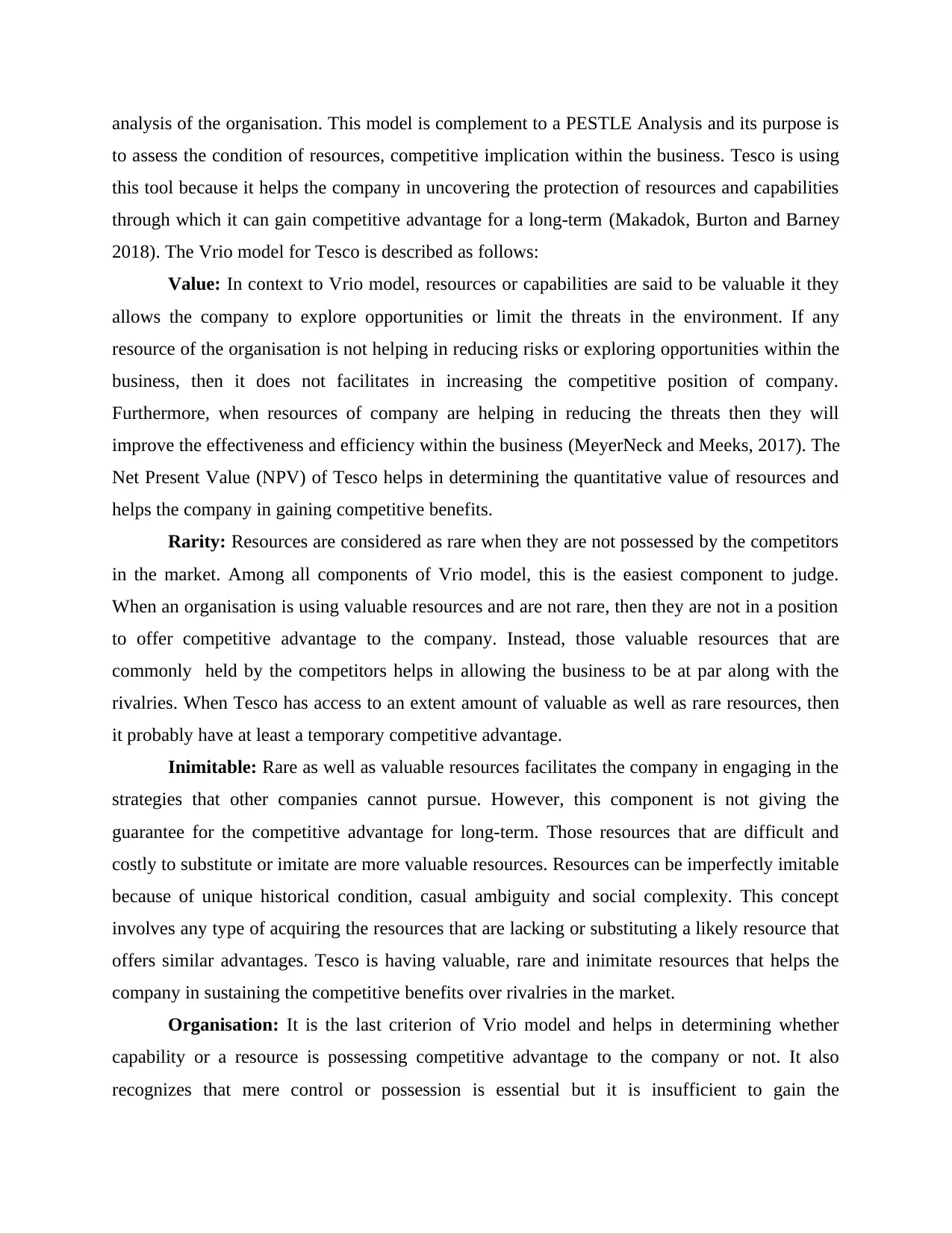
analysis of the organisation. This model is complement to a PESTLE Analysis and its purpose is
to assess the condition of resources, competitive implication within the business. Tesco is using
this tool because it helps the company in uncovering the protection of resources and capabilities
through which it can gain competitive advantage for a long-term (Makadok, Burton and Barney
2018). The Vrio model for Tesco is described as follows:
Value: In context to Vrio model, resources or capabilities are said to be valuable it they
allows the company to explore opportunities or limit the threats in the environment. If any
resource of the organisation is not helping in reducing risks or exploring opportunities within the
business, then it does not facilitates in increasing the competitive position of company.
Furthermore, when resources of company are helping in reducing the threats then they will
improve the effectiveness and efficiency within the business (MeyerNeck and Meeks, 2017). The
Net Present Value (NPV) of Tesco helps in determining the quantitative value of resources and
helps the company in gaining competitive benefits.
Rarity: Resources are considered as rare when they are not possessed by the competitors
in the market. Among all components of Vrio model, this is the easiest component to judge.
When an organisation is using valuable resources and are not rare, then they are not in a position
to offer competitive advantage to the company. Instead, those valuable resources that are
commonly held by the competitors helps in allowing the business to be at par along with the
rivalries. When Tesco has access to an extent amount of valuable as well as rare resources, then
it probably have at least a temporary competitive advantage.
Inimitable: Rare as well as valuable resources facilitates the company in engaging in the
strategies that other companies cannot pursue. However, this component is not giving the
guarantee for the competitive advantage for long-term. Those resources that are difficult and
costly to substitute or imitate are more valuable resources. Resources can be imperfectly imitable
because of unique historical condition, casual ambiguity and social complexity. This concept
involves any type of acquiring the resources that are lacking or substituting a likely resource that
offers similar advantages. Tesco is having valuable, rare and inimitate resources that helps the
company in sustaining the competitive benefits over rivalries in the market.
Organisation: It is the last criterion of Vrio model and helps in determining whether
capability or a resource is possessing competitive advantage to the company or not. It also
recognizes that mere control or possession is essential but it is insufficient to gain the
to assess the condition of resources, competitive implication within the business. Tesco is using
this tool because it helps the company in uncovering the protection of resources and capabilities
through which it can gain competitive advantage for a long-term (Makadok, Burton and Barney
2018). The Vrio model for Tesco is described as follows:
Value: In context to Vrio model, resources or capabilities are said to be valuable it they
allows the company to explore opportunities or limit the threats in the environment. If any
resource of the organisation is not helping in reducing risks or exploring opportunities within the
business, then it does not facilitates in increasing the competitive position of company.
Furthermore, when resources of company are helping in reducing the threats then they will
improve the effectiveness and efficiency within the business (MeyerNeck and Meeks, 2017). The
Net Present Value (NPV) of Tesco helps in determining the quantitative value of resources and
helps the company in gaining competitive benefits.
Rarity: Resources are considered as rare when they are not possessed by the competitors
in the market. Among all components of Vrio model, this is the easiest component to judge.
When an organisation is using valuable resources and are not rare, then they are not in a position
to offer competitive advantage to the company. Instead, those valuable resources that are
commonly held by the competitors helps in allowing the business to be at par along with the
rivalries. When Tesco has access to an extent amount of valuable as well as rare resources, then
it probably have at least a temporary competitive advantage.
Inimitable: Rare as well as valuable resources facilitates the company in engaging in the
strategies that other companies cannot pursue. However, this component is not giving the
guarantee for the competitive advantage for long-term. Those resources that are difficult and
costly to substitute or imitate are more valuable resources. Resources can be imperfectly imitable
because of unique historical condition, casual ambiguity and social complexity. This concept
involves any type of acquiring the resources that are lacking or substituting a likely resource that
offers similar advantages. Tesco is having valuable, rare and inimitate resources that helps the
company in sustaining the competitive benefits over rivalries in the market.
Organisation: It is the last criterion of Vrio model and helps in determining whether
capability or a resource is possessing competitive advantage to the company or not. It also
recognizes that mere control or possession is essential but it is insufficient to gain the
⊘ This is a preview!⊘
Do you want full access?
Subscribe today to unlock all pages.

Trusted by 1+ million students worldwide
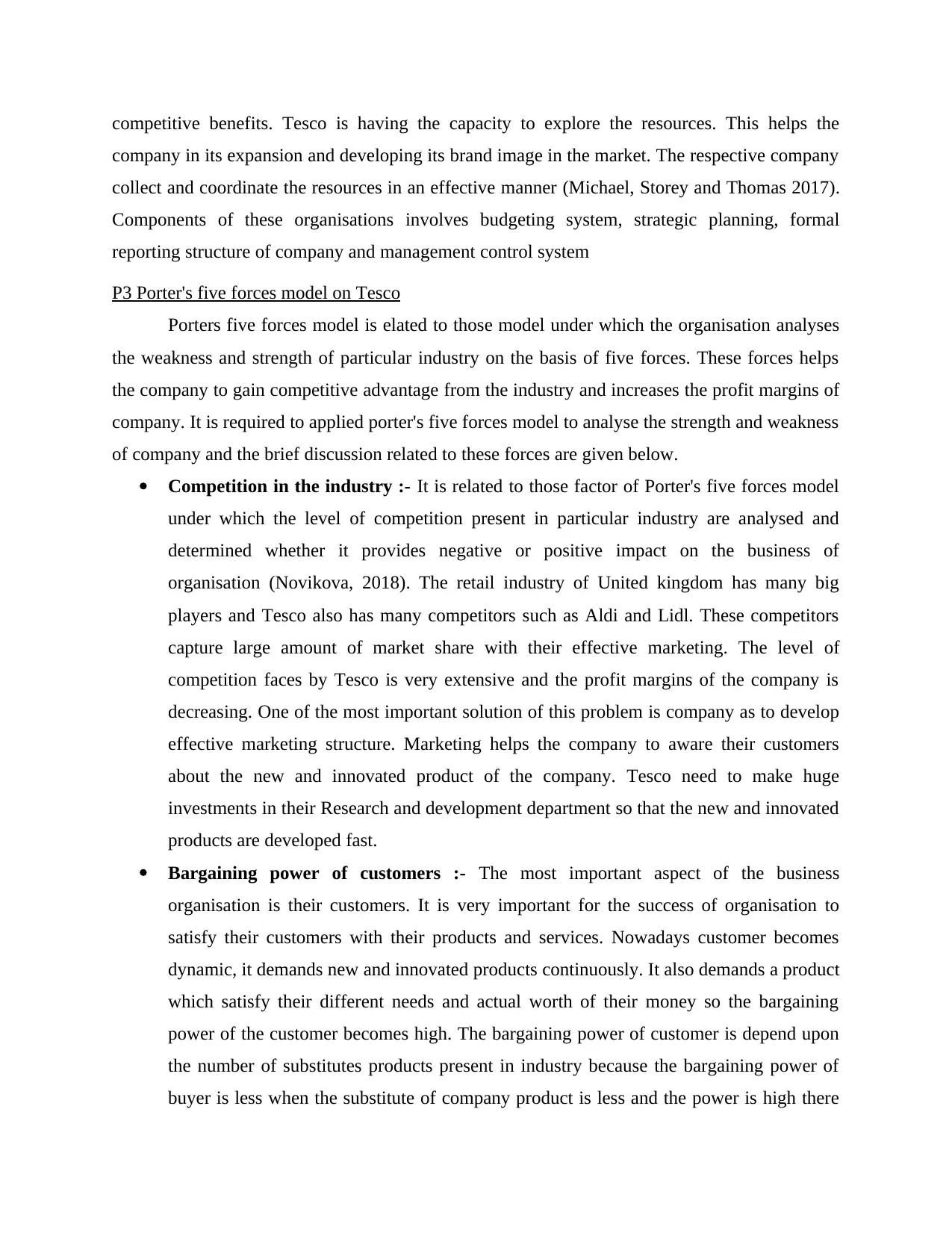
competitive benefits. Tesco is having the capacity to explore the resources. This helps the
company in its expansion and developing its brand image in the market. The respective company
collect and coordinate the resources in an effective manner (Michael, Storey and Thomas 2017).
Components of these organisations involves budgeting system, strategic planning, formal
reporting structure of company and management control system
P3 Porter's five forces model on Tesco
Porters five forces model is elated to those model under which the organisation analyses
the weakness and strength of particular industry on the basis of five forces. These forces helps
the company to gain competitive advantage from the industry and increases the profit margins of
company. It is required to applied porter's five forces model to analyse the strength and weakness
of company and the brief discussion related to these forces are given below.
Competition in the industry :- It is related to those factor of Porter's five forces model
under which the level of competition present in particular industry are analysed and
determined whether it provides negative or positive impact on the business of
organisation (Novikova, 2018). The retail industry of United kingdom has many big
players and Tesco also has many competitors such as Aldi and Lidl. These competitors
capture large amount of market share with their effective marketing. The level of
competition faces by Tesco is very extensive and the profit margins of the company is
decreasing. One of the most important solution of this problem is company as to develop
effective marketing structure. Marketing helps the company to aware their customers
about the new and innovated product of the company. Tesco need to make huge
investments in their Research and development department so that the new and innovated
products are developed fast.
Bargaining power of customers :- The most important aspect of the business
organisation is their customers. It is very important for the success of organisation to
satisfy their customers with their products and services. Nowadays customer becomes
dynamic, it demands new and innovated products continuously. It also demands a product
which satisfy their different needs and actual worth of their money so the bargaining
power of the customer becomes high. The bargaining power of customer is depend upon
the number of substitutes products present in industry because the bargaining power of
buyer is less when the substitute of company product is less and the power is high there
company in its expansion and developing its brand image in the market. The respective company
collect and coordinate the resources in an effective manner (Michael, Storey and Thomas 2017).
Components of these organisations involves budgeting system, strategic planning, formal
reporting structure of company and management control system
P3 Porter's five forces model on Tesco
Porters five forces model is elated to those model under which the organisation analyses
the weakness and strength of particular industry on the basis of five forces. These forces helps
the company to gain competitive advantage from the industry and increases the profit margins of
company. It is required to applied porter's five forces model to analyse the strength and weakness
of company and the brief discussion related to these forces are given below.
Competition in the industry :- It is related to those factor of Porter's five forces model
under which the level of competition present in particular industry are analysed and
determined whether it provides negative or positive impact on the business of
organisation (Novikova, 2018). The retail industry of United kingdom has many big
players and Tesco also has many competitors such as Aldi and Lidl. These competitors
capture large amount of market share with their effective marketing. The level of
competition faces by Tesco is very extensive and the profit margins of the company is
decreasing. One of the most important solution of this problem is company as to develop
effective marketing structure. Marketing helps the company to aware their customers
about the new and innovated product of the company. Tesco need to make huge
investments in their Research and development department so that the new and innovated
products are developed fast.
Bargaining power of customers :- The most important aspect of the business
organisation is their customers. It is very important for the success of organisation to
satisfy their customers with their products and services. Nowadays customer becomes
dynamic, it demands new and innovated products continuously. It also demands a product
which satisfy their different needs and actual worth of their money so the bargaining
power of the customer becomes high. The bargaining power of customer is depend upon
the number of substitutes products present in industry because the bargaining power of
buyer is less when the substitute of company product is less and the power is high there
Paraphrase This Document
Need a fresh take? Get an instant paraphrase of this document with our AI Paraphraser
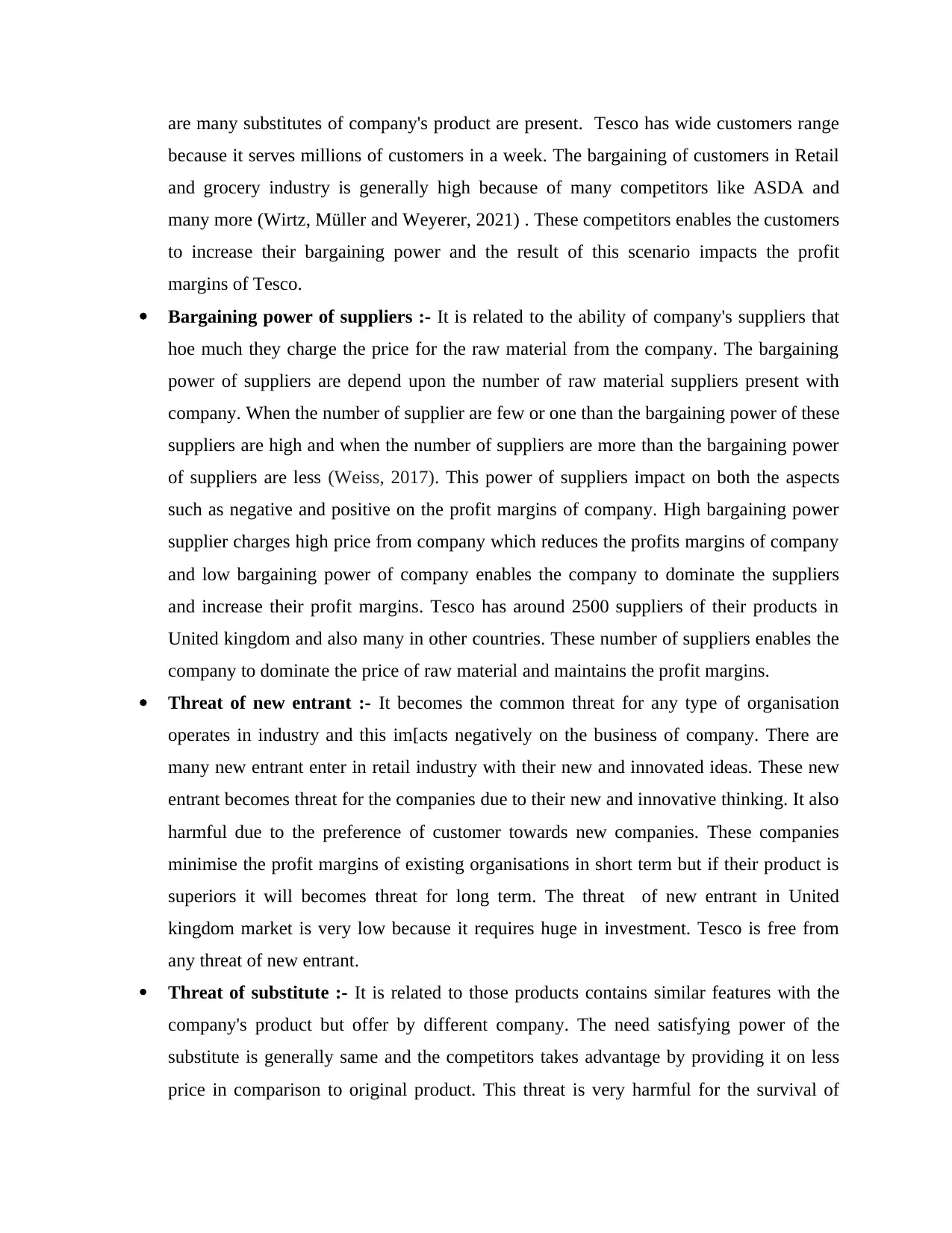
are many substitutes of company's product are present. Tesco has wide customers range
because it serves millions of customers in a week. The bargaining of customers in Retail
and grocery industry is generally high because of many competitors like ASDA and
many more (Wirtz, Müller and Weyerer, 2021) . These competitors enables the customers
to increase their bargaining power and the result of this scenario impacts the profit
margins of Tesco.
Bargaining power of suppliers :- It is related to the ability of company's suppliers that
hoe much they charge the price for the raw material from the company. The bargaining
power of suppliers are depend upon the number of raw material suppliers present with
company. When the number of supplier are few or one than the bargaining power of these
suppliers are high and when the number of suppliers are more than the bargaining power
of suppliers are less (Weiss, 2017). This power of suppliers impact on both the aspects
such as negative and positive on the profit margins of company. High bargaining power
supplier charges high price from company which reduces the profits margins of company
and low bargaining power of company enables the company to dominate the suppliers
and increase their profit margins. Tesco has around 2500 suppliers of their products in
United kingdom and also many in other countries. These number of suppliers enables the
company to dominate the price of raw material and maintains the profit margins.
Threat of new entrant :- It becomes the common threat for any type of organisation
operates in industry and this im[acts negatively on the business of company. There are
many new entrant enter in retail industry with their new and innovated ideas. These new
entrant becomes threat for the companies due to their new and innovative thinking. It also
harmful due to the preference of customer towards new companies. These companies
minimise the profit margins of existing organisations in short term but if their product is
superiors it will becomes threat for long term. The threat of new entrant in United
kingdom market is very low because it requires huge in investment. Tesco is free from
any threat of new entrant.
Threat of substitute :- It is related to those products contains similar features with the
company's product but offer by different company. The need satisfying power of the
substitute is generally same and the competitors takes advantage by providing it on less
price in comparison to original product. This threat is very harmful for the survival of
because it serves millions of customers in a week. The bargaining of customers in Retail
and grocery industry is generally high because of many competitors like ASDA and
many more (Wirtz, Müller and Weyerer, 2021) . These competitors enables the customers
to increase their bargaining power and the result of this scenario impacts the profit
margins of Tesco.
Bargaining power of suppliers :- It is related to the ability of company's suppliers that
hoe much they charge the price for the raw material from the company. The bargaining
power of suppliers are depend upon the number of raw material suppliers present with
company. When the number of supplier are few or one than the bargaining power of these
suppliers are high and when the number of suppliers are more than the bargaining power
of suppliers are less (Weiss, 2017). This power of suppliers impact on both the aspects
such as negative and positive on the profit margins of company. High bargaining power
supplier charges high price from company which reduces the profits margins of company
and low bargaining power of company enables the company to dominate the suppliers
and increase their profit margins. Tesco has around 2500 suppliers of their products in
United kingdom and also many in other countries. These number of suppliers enables the
company to dominate the price of raw material and maintains the profit margins.
Threat of new entrant :- It becomes the common threat for any type of organisation
operates in industry and this im[acts negatively on the business of company. There are
many new entrant enter in retail industry with their new and innovated ideas. These new
entrant becomes threat for the companies due to their new and innovative thinking. It also
harmful due to the preference of customer towards new companies. These companies
minimise the profit margins of existing organisations in short term but if their product is
superiors it will becomes threat for long term. The threat of new entrant in United
kingdom market is very low because it requires huge in investment. Tesco is free from
any threat of new entrant.
Threat of substitute :- It is related to those products contains similar features with the
company's product but offer by different company. The need satisfying power of the
substitute is generally same and the competitors takes advantage by providing it on less
price in comparison to original product. This threat is very harmful for the survival of
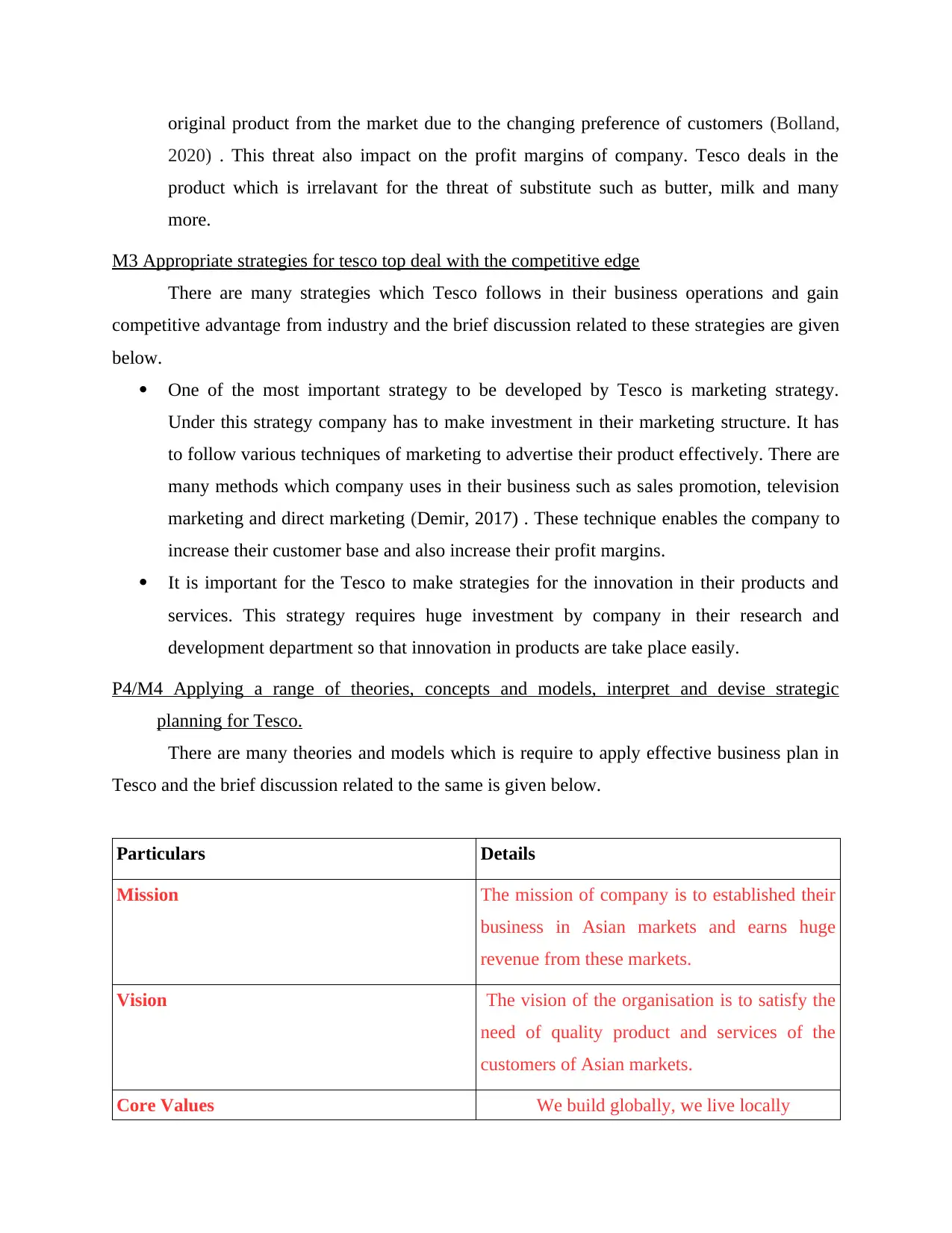
original product from the market due to the changing preference of customers (Bolland,
2020) . This threat also impact on the profit margins of company. Tesco deals in the
product which is irrelavant for the threat of substitute such as butter, milk and many
more.
M3 Appropriate strategies for tesco top deal with the competitive edge
There are many strategies which Tesco follows in their business operations and gain
competitive advantage from industry and the brief discussion related to these strategies are given
below.
One of the most important strategy to be developed by Tesco is marketing strategy.
Under this strategy company has to make investment in their marketing structure. It has
to follow various techniques of marketing to advertise their product effectively. There are
many methods which company uses in their business such as sales promotion, television
marketing and direct marketing (Demir, 2017) . These technique enables the company to
increase their customer base and also increase their profit margins.
It is important for the Tesco to make strategies for the innovation in their products and
services. This strategy requires huge investment by company in their research and
development department so that innovation in products are take place easily.
P4/M4 Applying a range of theories, concepts and models, interpret and devise strategic
planning for Tesco.
There are many theories and models which is require to apply effective business plan in
Tesco and the brief discussion related to the same is given below.
Particulars Details
Mission The mission of company is to established their
business in Asian markets and earns huge
revenue from these markets.
Vision The vision of the organisation is to satisfy the
need of quality product and services of the
customers of Asian markets.
Core Values We build globally, we live locally
2020) . This threat also impact on the profit margins of company. Tesco deals in the
product which is irrelavant for the threat of substitute such as butter, milk and many
more.
M3 Appropriate strategies for tesco top deal with the competitive edge
There are many strategies which Tesco follows in their business operations and gain
competitive advantage from industry and the brief discussion related to these strategies are given
below.
One of the most important strategy to be developed by Tesco is marketing strategy.
Under this strategy company has to make investment in their marketing structure. It has
to follow various techniques of marketing to advertise their product effectively. There are
many methods which company uses in their business such as sales promotion, television
marketing and direct marketing (Demir, 2017) . These technique enables the company to
increase their customer base and also increase their profit margins.
It is important for the Tesco to make strategies for the innovation in their products and
services. This strategy requires huge investment by company in their research and
development department so that innovation in products are take place easily.
P4/M4 Applying a range of theories, concepts and models, interpret and devise strategic
planning for Tesco.
There are many theories and models which is require to apply effective business plan in
Tesco and the brief discussion related to the same is given below.
Particulars Details
Mission The mission of company is to established their
business in Asian markets and earns huge
revenue from these markets.
Vision The vision of the organisation is to satisfy the
need of quality product and services of the
customers of Asian markets.
Core Values We build globally, we live locally
⊘ This is a preview!⊘
Do you want full access?
Subscribe today to unlock all pages.

Trusted by 1+ million students worldwide
1 out of 19
Related Documents
Your All-in-One AI-Powered Toolkit for Academic Success.
+13062052269
info@desklib.com
Available 24*7 on WhatsApp / Email
![[object Object]](/_next/static/media/star-bottom.7253800d.svg)
Unlock your academic potential
Copyright © 2020–2025 A2Z Services. All Rights Reserved. Developed and managed by ZUCOL.



